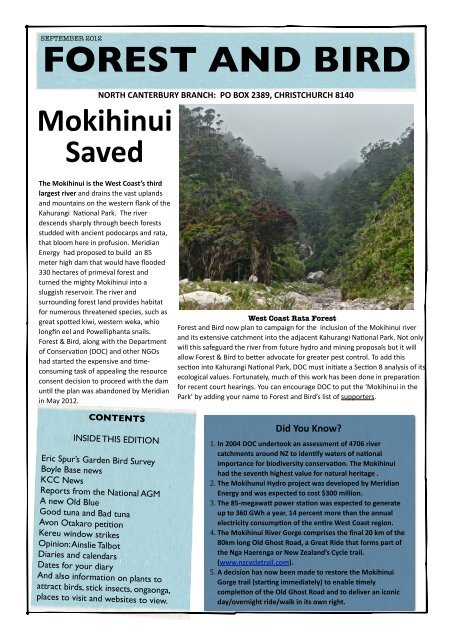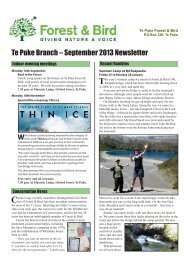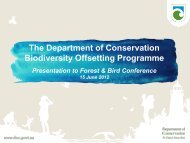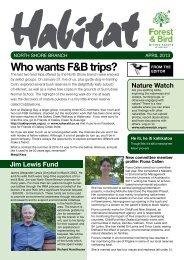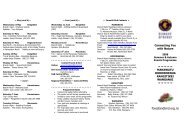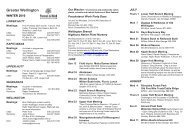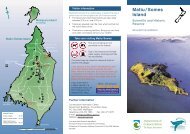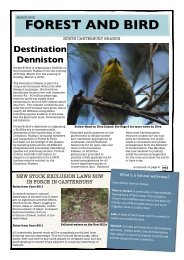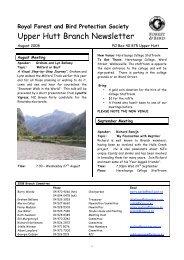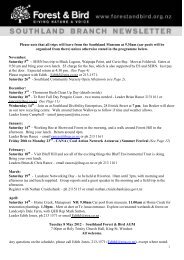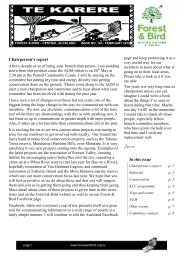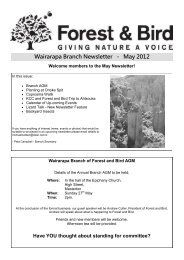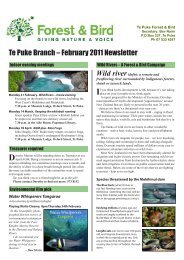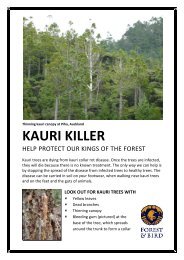Boyle Base News - Forest and Bird
Boyle Base News - Forest and Bird
Boyle Base News - Forest and Bird
Create successful ePaper yourself
Turn your PDF publications into a flip-book with our unique Google optimized e-Paper software.
SEPTEMBER 2012<br />
FOREST AND BIRD<br />
NORTH CANTERBURY BRANCH: PO BOX 2389, CHRISTCHURCH 8140<br />
Mokihinui<br />
Saved<br />
The Mokihinui is the West Coast’s third<br />
largest river <strong>and</strong> drains the vast upl<strong>and</strong>s<br />
<strong>and</strong> mountains on the western flank of the<br />
Kahurangi Na8onal Park. The river<br />
descends sharply through beech forests<br />
studded with ancient podocarps <strong>and</strong> rata,<br />
that bloom here in profusion. Meridian<br />
Energy had proposed to build an 85<br />
meter high dam that would have flooded<br />
330 hectares of primeval forest <strong>and</strong><br />
turned the mighty Mokihinui into a<br />
sluggish reservoir. The river <strong>and</strong><br />
surrounding forest l<strong>and</strong> provides habitat<br />
for numerous threatened species, such as<br />
great spoFed kiwi, western weka, whio<br />
longfin eel <strong>and</strong> Powelliphanta snails.<br />
<strong>Forest</strong> & <strong>Bird</strong>, along with the Department<br />
of Conserva8on (DOC) <strong>and</strong> other NGOs<br />
had started the expensive <strong>and</strong> 8me-‐<br />
consuming task of appealing the resource<br />
consent decision to proceed with the dam<br />
un8l the plan was ab<strong>and</strong>oned by Meridian<br />
in May 2012.<br />
CONTENTS<br />
INSIDE THIS EDITION<br />
Eric Spur’s Garden <strong>Bird</strong> Survey<br />
<strong>Boyle</strong> <strong>Base</strong> news<br />
KCC <strong>News</strong><br />
Reports from the National AGM<br />
A new Old Blue<br />
Good tuna <strong>and</strong> Bad tuna<br />
Avon Otakaro petition<br />
Kereu window strikes<br />
Opinion: Ainslie Talbot<br />
Diaries <strong>and</strong> calendars<br />
Dates for your diary<br />
And also information on plants to<br />
attract birds, stick insects, ongaonga,<br />
places to visit <strong>and</strong> websites to view.<br />
A Hurunui local . See great places to visit page<br />
West Coast Rata <strong>Forest</strong><br />
<strong>Forest</strong> <strong>and</strong> <strong>Bird</strong> now plan to campaign for the inclusion of the Mokihinui river<br />
<strong>and</strong> its extensive catchment into the adjacent Kahurangi Na8onal Park. Not only<br />
will this safeguard the river from future hydro <strong>and</strong> mining proposals but it will<br />
allow <strong>Forest</strong> & <strong>Bird</strong> to beFer advocate for greater pest control. To add this<br />
sec8on into Kahurangi Na8onal Park, DOC must ini8ate a Sec8on 8 analysis of its<br />
ecological values. Fortunately, much of this work has been done in prepara8on<br />
for recent court hearings. You can encourage DOC to put the ‘Mokihinui in the<br />
Park’ by adding your name to <strong>Forest</strong> <strong>and</strong> <strong>Bird</strong>’s list of supporters.<br />
Did You Know?<br />
1. In 2004 DOC undertook an assessment of 4706 river<br />
catchments around NZ to idenVfy waters of naVonal<br />
importance for biodiversity conservaVon. The Mokihinui<br />
had the seventh highest value for natural heritage .<br />
2. The Mokihunui Hydro project was developed by Meridian<br />
Energy <strong>and</strong> was expected to cost $300 million.<br />
3. The 85-‐megawa` power staVon was expected to generate<br />
up to 360 GWh a year, 14 percent more than the annual<br />
electricity consumpVon of the enVre West Coast region.<br />
4. The Mokihinui River Gorge comprises the final 20 km of the<br />
80km long Old Ghost Road, a Great Ride that forms part of<br />
the Nga Haerenga or New Zeal<strong>and</strong>’s Cycle trail.<br />
(www.nzcycletrail.com).<br />
5. A decision has now been made to restore the Mokihinui<br />
Gorge trail (starVng immediately) to enable Vmely<br />
compleVon of the Old Ghost Road <strong>and</strong> to deliver an iconic<br />
day/overnight ride/walk in its own right.
<strong>Boyle</strong> <strong>Base</strong> <strong>News</strong><br />
During winter, the weather has brought<br />
rain <strong>and</strong> more rain, followed by a heavy<br />
wet snow which brutally broke trees <strong>and</strong><br />
branches in the red, silver <strong>and</strong> mountain<br />
beech forest. There was about a week of<br />
lovely weather, then more rain.<br />
Goodness knows what we will face when<br />
we tackle our August monitoring. I<br />
suspect it will take us all day, to do a line<br />
of 10 monitoring boxes where it might<br />
have taken an hour. Who Knows? We<br />
may be busy, doing the 4 lines, as 3 lines<br />
are deep in the broken beech forest.<br />
Sadly the June snows appear to have<br />
broken branches off the 3 mountain<br />
beech trees, between the hut <strong>and</strong> the<br />
toilet, where the orange flowered<br />
mistletoe (Alepis flavida) flourished. The<br />
mistletoes were, of great interest, <strong>and</strong><br />
therefore they are a great loss. There are<br />
other mistletoes but they are not as<br />
h<strong>and</strong>y for a teaching aid. There were<br />
even many branches down on the track<br />
from the hut to the toilet. The bush is<br />
liFered with trees down as well as<br />
branches.<br />
Viciously, that wet cold snow broke<br />
branches off kanuka <strong>and</strong> damaged<br />
severely even tough old matagouries. The<br />
damage is visible every-‐where. The <strong>Boyle</strong><br />
Area is a very dynamic area, even though<br />
the <strong>Boyle</strong> <strong>Base</strong> Hut is down on the flats.<br />
The Great news in July was the<br />
installa8on of a solar ligh8ng system to<br />
<strong>Boyle</strong> <strong>Base</strong> Hut. We give sincere thanks<br />
to the grant, from the Canterbury<br />
Community Trust. C<strong>and</strong>les as a fire<br />
hazard, were a constant worry, in spite of<br />
some people being concerned that <strong>Boyle</strong><br />
<strong>Base</strong> will lose its ambience. [We’d cut<br />
down the fire danger down right at the<br />
outset Aeer taking possession of <strong>Boyle</strong><br />
<strong>Base</strong> Hut we replaced in the living/room<br />
kitchen old fashioned Pinex par8cle<br />
board, with Fireline, which is an up<br />
market version of Gib Board]<br />
As ever we warmly welcome volunteers,<br />
par8cularly those wan8ng to do predator<br />
trapping.<br />
[Ideally the Fenn 4 kill traps should be<br />
gone round every couple of weeks.] As<br />
Wayne K. says a trap out of ac8on is an<br />
opportunity missed.<br />
A presentaVon at the North Canterbury<br />
Branch AGM by Eric Spurr<br />
The annual garden bird survey run by L<strong>and</strong>care Research<br />
<strong>and</strong> supported by <strong>Forest</strong> & <strong>Bird</strong> <strong>and</strong> the Ornithological<br />
Society took place this year from June 30 th to July 8 th <strong>and</strong><br />
by all accounts was a great success with over 4000 birders<br />
taking part. The survey, running since 2006, encourages amateur <strong>and</strong> expert<br />
bird watchers alike to take a look at just exactly which avian visitors frequent<br />
their backyards. It involves spending an hour recording the species of birds <strong>and</strong><br />
the maximum number of each seen or heard at any one 8me over that hour.<br />
Survey organiser <strong>and</strong> re8red Canterbury L<strong>and</strong>care Research scien8st Eric Spurr<br />
is happy with the outcome. "The response from par8cipants throughout the<br />
country has been fantas8c. Their observa8ons help build up a picture of how<br />
both na8ve <strong>and</strong> introduced birds are faring in our gardens over the years."<br />
Results from this year’s survey had the house sparrow again being the most<br />
abundant bird species, followed by silvereye, blackbird <strong>and</strong> starling. Other birds<br />
in order of abundance were the tui, myna, chaffinch, fantail, greenfinch <strong>and</strong><br />
dunnock. Some of the more unusual birds reported included fernbird, kea, New<br />
Zeal<strong>and</strong> robin, white heron <strong>and</strong> kookaburra.<br />
The Garden <strong>Bird</strong> Survey<br />
"The most significant result this year has been an increase in the number of<br />
silvereye counted. This could have been a result of snow <strong>and</strong> hard frosts in early<br />
winter forcing birds out of forests <strong>and</strong> into gardens in search of food. Last year<br />
the early winter was mild, so birds didn't move into gardens un8l later."<br />
What species of birds do you see in your garden? <strong>Base</strong>d on past survey results if<br />
you are in an urban sepng then you are likely to see higher numbers of<br />
silvereyes, sparrows <strong>and</strong> greenfinches compared to your rural counterparts <strong>and</strong>,<br />
if you provide supplementary feed to these birds ( bread, fruit, fat or sugar-‐<br />
water), their numbers will most likely significantly increase.<br />
If you missed out on this year’s survey make sure to make a note to check out<br />
the dates for next year. Surveys can be submiFed by post or can be<br />
conveniently filled out online at the L<strong>and</strong>care Research website.<br />
More informa8on on the garden bird survey, including analysis of long-‐term<br />
survey results can be found at hFp://www.l<strong>and</strong>careresearch.co.nz/science/<br />
plants-‐animals-‐fungi/animals/birds/garden-‐bird-‐surveys
Plants to a`ract<br />
naVve birds<br />
Harakeke/Flax<br />
Harakeke/Flax. The first European<br />
traders called it "flax" because its<br />
fibres were similar to that of true flax<br />
found in other parts of the world.<br />
Though we sVll call it flax today,<br />
harakeke is really a lily. It is unique to<br />
New Zeal<strong>and</strong> <strong>and</strong> is one of our oldest<br />
plant species. Tui, bellbirds,<br />
saddlebacks, short tailed bats, geckos<br />
<strong>and</strong> several types of insects enjoy<br />
nectar from the flax flower. It flowers<br />
spring to summer. Available in many<br />
hybrid forms from most garden centres<br />
it can be very a`racVve in the garden.<br />
The Omahuta forest lies to the west<br />
of the more famous Puketi forest in<br />
Northl<strong>and</strong> <strong>and</strong> has some treasures of its<br />
own. The tree above is called Hokianga <strong>and</strong><br />
is the 8th largest kauri in NZ.<br />
KCC <strong>News</strong><br />
The kids at the second KCC Leaf Olympics<br />
in Hagley Park celebrated the magic of<br />
leaves. Events were greatly enjoyed by<br />
par8cipants who made their own shot-‐put<br />
balls then fired them. They jumped,<br />
rolled, buried the adults, <strong>and</strong> searched for<br />
treasure to name a few ac8vi8es under<br />
the direc8on of volunteer parent Steve<br />
Muir. Many thanks Steve we look forward<br />
to the third Leaf Olympics!<br />
The Rangitata River, in the high country, is<br />
a great place to fish, rae, hike, take photos,<br />
watch birds <strong>and</strong> botanise. Rose Clucas<br />
treated us to some of our seldom seen<br />
na8ve galaxia <strong>and</strong> upl<strong>and</strong> bully species.<br />
She also neFed eels, a perch <strong>and</strong> a trout<br />
for the kids to see them close up. We saw<br />
Three Great Places to find a Kauri<br />
The Yakas tree in the Waipoua forest is<br />
named after a Dalmatian gum digger who<br />
knew of the tree for many years but only<br />
revealed this wonder’s location to the public<br />
in 1966. This is the 7th largest kauri in NZ.<br />
salmon swimming up river to spawn <strong>and</strong><br />
a few that had already made their redds<br />
<strong>and</strong> died. The RDR showed us another<br />
side of the river. Demonstra8ng how<br />
much water is removed for human<br />
ac8vity, namely hydro electricity <strong>and</strong><br />
irriga8on of the Canterbury Plains. An<br />
enjoyable weekend for all.<br />
Leh <strong>and</strong> aboveThe dead slamon<br />
didn't smell so good! Rose led<br />
the kids through the didymo<br />
check <strong>and</strong> cleaning process.<br />
If you would like more<br />
informa8on about KCC<br />
please call Eleanor 332<br />
9746 or email<br />
bissell@actrix.co.nz.<br />
Victoria Park does have at least two<br />
Kauri trees. Both are young examples<br />
but still good fun to try <strong>and</strong> find with<br />
the kids. They are within 100 metres of<br />
the visitor centre towards Bowenvale.
<strong>Forest</strong> & <strong>Bird</strong> NaVonal Conference 2012<br />
This year two delegates from the North Canterbury branch made their way to Wellington to a`end the NaVonal Conference<br />
below they give us their accounts of the highlights <strong>and</strong> most important messages that were given to our members.<br />
Lesley Sh<strong>and</strong><br />
With over a thous<strong>and</strong> members, the North Canterbury Branch gets 2 delegates. <strong>Forest</strong> <strong>and</strong> <strong>Bird</strong> has more than 50 branches <strong>and</strong><br />
most of them were represented at the annual June Conference, which was followed by the <strong>Forest</strong> <strong>and</strong> <strong>Bird</strong>’s A.G.M. This 8me<br />
Lesley Sh<strong>and</strong> <strong>and</strong> Greg BenneF were your representa8ves on Council at the <strong>Forest</strong> <strong>and</strong> <strong>Bird</strong> A.G.M.<br />
Te Papa was the 2012 F&B Conference Venue, <strong>and</strong> it seemed to me, there was a star-‐studded line up of speakers.<br />
I personally was excited at the prospect of listening, in flesh to, F&B’s keynote speaker, Gareth Morgan. In January Gareth<br />
Morgan had sold his Kiwi Saver <strong>and</strong> Investment Business to Kiwi Bank. In May he’d challenged the government to provide<br />
beFer planning rules to allocate marine space in places like the Marlbough Sounds.<br />
To me, I was sad, because he did not live up to my expecta8ons. He began his address by decrying conserva8onists concerns<br />
that certain fish stocks were being depleted, quo8ng the lack of concern by the independent, “Marine Stewardship Council”.<br />
Personally I felt his faith in the, “Marine Stewardship Council,” was misplaced knowing the concerns, many knowledgeable<br />
people/scien8sts had about fish species’ deple8on or collapse.<br />
I also found myself reflec8ng <strong>and</strong> wondering. Official fisheries observers are only on a modest % of fishery vessels in the hoki<br />
<strong>and</strong> southern blue whi8ng fisheries, <strong>and</strong> they report by far the greatest bycatch of fur seals. Yet all fishing vessels are legally<br />
obliged to report bycatch of marine animals.<br />
Gareth Morgan then cri8cized sincere <strong>Forest</strong> <strong>and</strong> <strong>Bird</strong> members for not being facts based, but presented few facts, to back his<br />
point of view. He then proceeded to use buzz words, like climate change, but I waited for him to men8on indigenous<br />
biodiversity, or even biodiversity. I knew most <strong>Forest</strong> <strong>and</strong> <strong>Bird</strong> members there had spent much of their lives trying to improve<br />
indigenous biodiversity in their local area. Sadly although this topic was of high interest, <strong>and</strong> worth exploring, it was not<br />
touched on. He was accurately reported in the paper, but were his cri8cisms of conserva8onists jus8fied?<br />
-‐I’ll leave you to judge this.<br />
Another topic that really excited me was: Predator Free NZ. F&B ‘s Nicola Toki [nee Vallance] presented the vision of a predator<br />
free NZ. She brought us up to date with this vision. 20 scien8sts/experts had gathered during this winter, to consider the<br />
ques8on of predator eradica8on <strong>and</strong> whether it was only a dream, or really a possibly. Those experts believed it possible, even<br />
if it takes 50 years to get the last predator.<br />
I was given great hope for the future by the aspira8ons by TV personality, Te Radar who convened a group of 6 young<br />
conserva8onists who had a very varied focus. They were from high schools, or representa8ve groups with a commitment to<br />
conserva8on, or university students. They had all had a passionate interest at promo8ng nature, but their focus might include<br />
biodiversity, the Antarc8c, or sub-‐Antarc8c Isl<strong>and</strong>s, also a cultural shie from fossil fuel dependency. One lad, with a ton of<br />
personality, had appointed himself “Campaign Manager” for seeing the saddleback <strong>and</strong> won F&B’s <strong>Bird</strong> of the Year<br />
compe88on!<br />
Dame Anne Salmon, the anthropologist, NZ historian <strong>and</strong> writer gave the S<strong>and</strong>erson Memorial address. She obviously had a<br />
passion for conserva8on, <strong>and</strong> described an area near Gisborne, where she had been involved for about 12 years, restoring <strong>and</strong><br />
enhancing habitats for beFer protec8on of indigenous species.<br />
This year at the AGM there was no elec8on of members to the execu8ve, as there was exactly the same number of c<strong>and</strong>idates<br />
to places on the execu8ve to be filled. Your North Canterbury c<strong>and</strong>idates had it easy this year.
Greg Benne`<br />
I arrived at the conference on Friday night in 8me to catch a panel discussion with six young conserva8onists <strong>and</strong> aptly<br />
facilitated by Te Radar with the main theme examining the idea of intergenera8onal thee. The theory proposes that current<br />
genera8ons, through exploita8on of resources, are effec8vely stealing from the next <strong>and</strong> future genera8ons. Thought<br />
provoking stuff to start the conference off.<br />
A highlight of the Conference was hearing Gareth Morgan's keynote speech. I had been looking forward to this; I have followed<br />
Gareth's exploits for some 8me now. I highly recommend his balanced look at the climate change debate in his book Poles<br />
Apart <strong>and</strong> I recently donated $20 to his Million Dollar Mouse Campaign to finally rid the Anitpodes Isl<strong>and</strong>s of rodents. I have at<br />
the top of my reading list his take on the fishing issues: Hook Line <strong>and</strong> Blinkers. Gareth gave a 15 minute speech that generated<br />
some media interest with about 30 seconds of the more controversial aspects making TV One news. Whilst we don't all<br />
necessarily agree with Gareth's views he shows that he is interested <strong>and</strong> he does research his topics before offering comment.<br />
Rather than report here what he said in his keynote speech I recommend visi8ng his website <strong>and</strong> read his blog on the<br />
environment <strong>and</strong> climate change: hFp://garethsworld.com/not-‐so-‐pure to get his views from the horse’s mouth. Go to the<br />
<strong>Forest</strong> & <strong>Bird</strong> conference website to hear his full speech.<br />
Both Gareth <strong>and</strong> Te Radar were not obliged to stay for the remainder of the conference aeer mee8ng their commitments but<br />
to their credit both of them did stay <strong>and</strong> showed real interest in the topics that followed.<br />
Truly inspira8onal was a series of speeches <strong>and</strong> panel discussion by some of our primary producers including current na8onal<br />
president Bruce Wills who recently was the subject of TV's Country Calendar. The Kiwi Fruit industry was represented by<br />
Alistair Mowat who focused on the environmental impacts of kiwifruit produc8on. Dan Steele the owner of Blue Duck Sta8on,<br />
a working sheep & beef sta8on at Owhango which also is home to a popula8on of whio, shared his experiences hFp://<br />
www.blueducksta8on.co.nz/ <strong>and</strong> my favourite was Jeff Williams, a self-‐styled “biological farmer” who owned <strong>and</strong> operated a<br />
conven8onal dairy farm for many years un8l having his “ah ha” moment when realising that; “Man, despite his ar8s8c<br />
preten8ons, his sophis8ca8on <strong>and</strong> his many accomplishments, owes his existence to a six inch layer of top soil <strong>and</strong> the fact<br />
that it rains.” Jeff started looking aeer his soil using biological inputs rather than synthe8c fer8lisers with astounding results.<br />
His methods were showcased recently in issue 23 of Good magazine <strong>and</strong> well worth a read. It is very interes8ng to note that<br />
he reduced stock numbers to 1980 levels <strong>and</strong> reduced his farm income by $200,000 per year but has saved farm costs by<br />
$400,000 per year.<br />
There were many other interes8ng speakers. The always eloquent Tami8 Kruger told the tragic history of the Tuhoe people <strong>and</strong><br />
the Te Urewera Na8onal park. Parliamentary Commissioner of the environment Dr Jan Wright gave a brief overview of the<br />
issues that her commission have been dealing with. She posed an interes8ng ques8on: Would the damming of the Mokihinui<br />
be acceptable if the trade-‐off were to be that mammalian pests were managed throughout the South Isl<strong>and</strong>?<br />
There were many other highlights of the conference that are too numerous to men8on here but I recommend visi8ng the<br />
conference website: hFp://www.forest<strong>and</strong>bird.org.nz/conference2012 to get a full report. The best part of the whole<br />
conference was to meet <strong>and</strong> swap stories with like minded people from all over the country.<br />
ELEANOR BISSELL: OLD BLUE<br />
It was announced at the <strong>Forest</strong> <strong>and</strong> <strong>Bird</strong> annual conference that Eleanor Bissell had been<br />
awarded the society’s highest honour, an Old Blue. Eleanor has been an inspira8onal force in<br />
North Canterbury running the local KCC branch for more than 15 years <strong>and</strong> working 8relessly on<br />
local restora8on projects. Despite being forced from her home by the earthquakes Eleanor has<br />
con8nued to contribute generously with her 8me for North Canterbury <strong>Forest</strong> <strong>and</strong> <strong>Bird</strong>. Jane<br />
Demeter, who works with Eleanor in KCC, says Eleanor Bissell's enthusiasm, energy <strong>and</strong> passion<br />
st<strong>and</strong> out. "She is incredibly empathe8c with children, the kids love her. She is incredibly<br />
crea8ve”. Ann Graeme, KCC Na8onal Coordinator, says of her “She is a natural leader, to watch<br />
her with children is quite a revela8on. She had been a teacher <strong>and</strong> this shows in the way she<br />
presents things in imagina8ve way”<br />
In North Canterbury we have known for a long 8me what a treasure Eleanor is <strong>and</strong> now the<br />
whole country knows as well. Warmest congratula8ons on this well-‐deserved award.
Avon-‐Otakaro<br />
Pe88on<br />
On 2 nd May former Bexley residents<br />
Allan <strong>and</strong> Helen Campbell, with<br />
Avon-‐Otakaro Network co-‐chair<br />
Mark Gibson, delivered a pe88on to<br />
Christchurch MPs Lianne Dalziel <strong>and</strong><br />
Eugenie Sage on the steps of<br />
Parliament. The pe88on, signed by<br />
more than 18,500 Christchurch<br />
people asks Parliament “to work<br />
with the people <strong>and</strong> local<br />
authori8es of Christchurch to<br />
ensure that the Avon River red zone<br />
becomes a reserve <strong>and</strong> river park<br />
when the homeowners have to<br />
leave.”<br />
More than 1000 sheets of flax<br />
paper were used to create the two<br />
large volumes<br />
The day before the two h<strong>and</strong>-‐bound<br />
volumes of the pe88on were<br />
carried up the Avon River to its<br />
Avonhead source, <strong>and</strong> then to the<br />
airport. A symbolic journey<br />
emphasising the river’s role in<br />
uni8ng the city.<br />
Good Tuna, Bad Tuna<br />
Karlie Thomas<br />
Oceans campaigner<br />
Greenpeace NZ<br />
World Oceans Day – a day to celebrate all that the oceans give us <strong>and</strong> we marked<br />
the day by giving two NZ companies a sustainability award.<br />
The oceans provide us with food, jobs <strong>and</strong> the very oxygen we breathe -‐ if we are to<br />
survive on this planet, we need living oceans. However, decades of overfishing,<br />
destruc8ve fishing <strong>and</strong> pollu8on is altering our oceans forever <strong>and</strong> threatening their<br />
capacity to sustain us. For example, here in NZ most of New Zeal<strong>and</strong>’s canned tuna<br />
comes from the Pacific which, un8l recently, had the world's last healthy tuna<br />
fisheries. But these too are now under threat from overfishing <strong>and</strong> destruc8ve fishing<br />
methods. But there is hope!<br />
GOOD TUNA<br />
More <strong>and</strong> more tuna br<strong>and</strong>s around the world are taking responsibility by saying no<br />
to tuna caught this way <strong>and</strong> instead suppor8ng more sustainable fishing methods.<br />
Here in NZ these ‘greener’ FAD-‐free tuna products are being sold in New Zeal<strong>and</strong><br />
thanks to Pams <strong>and</strong> Fish 4 Ever. It takes leadership <strong>and</strong> commitment to move<br />
towards the sustainable fishing methods essen8al to protec8ng our oceans for the<br />
next genera8ons -‐-‐ so it’s great to see some kiwi companies doing the right thing! So<br />
if you get any canned tuna, look for pole <strong>and</strong> line caught tuna like PAMS or Fish 4<br />
Ever.<br />
BAD TUNA<br />
NZ’s biggest canned tuna company Sealord is s8lling buying its tuna from vessels<br />
using destruc8ve fishing methods which leaves threatened sharks, juvenile tuna <strong>and</strong><br />
even turtles dead in its wake as this video shows. But they too will have to make the<br />
switch to good tuna if they hear from enough people that it’s 8me to change their<br />
tuna. For more informa8on. hFp://www.greenpeace.org/new-‐zeal<strong>and</strong><br />
WEBSITES OF INTEREST<br />
<strong>Bird</strong>s of Christchurch <strong>and</strong> Canterbury<br />
A site for people interested in bird conservation in Canterbury<br />
This site is dedicated to the wildlife of<br />
Christchurch <strong>and</strong> Canterbury. The inten8on of<br />
the site is to raise public awareness <strong>and</strong><br />
enjoyment by sharing knowledge. Here you<br />
can find informa8on about the species found<br />
in this region. You can also view daily updates<br />
of the latest sigh8ngs for birds <strong>and</strong> other<br />
wildlife.<br />
Subscribe to this site for free you <strong>and</strong> you will<br />
receive any new reports as soon as they are<br />
published.<br />
The web site is dedicated to the<br />
birds of Canterbury <strong>and</strong> provides<br />
lis8ngs of observa8ons <strong>and</strong><br />
informa8on regarding first arrival<br />
<strong>and</strong> departure dates of migrant<br />
species. <strong>Bird</strong>s of interest or counts<br />
are published <strong>and</strong> subscribers are<br />
invited to contribute <strong>and</strong> submit<br />
data <strong>and</strong> photographs. If you would<br />
like more informa8on then email<br />
Niall.mugan@gmail.com<br />
(Independent Ornithologist).
Perfect camouflage<br />
NEW ZEALAND<br />
STICK INSECTS<br />
The are 3000 species of<br />
stick insect worldwide <strong>and</strong> at<br />
least 23 species that are<br />
indigenous to New Zeal<strong>and</strong>.<br />
The stick insect comes<br />
from the insect order<br />
Phasmatodea which gains its<br />
name from the Greek word<br />
for phantom.<br />
Stick insects generally feed<br />
after dark on a range of native<br />
<strong>and</strong> non-native vegetation.<br />
<strong>Bird</strong>s are their main<br />
predator <strong>and</strong> generally hunt<br />
by sight. Stick insects have<br />
evolved <strong>and</strong> natural selection<br />
has driven them to develop<br />
the most extreme form of<br />
camouflage.<br />
When threatened stick<br />
insects will fall to the ground<br />
<strong>and</strong> can play dead for hours.<br />
Stick insects are able to<br />
practice parthenogenesis<br />
which means they can<br />
reproduce without males.<br />
Argosarchus horridus is<br />
New Zeal<strong>and</strong>’s largest stick<br />
insect. The females can be 20<br />
centimetres long.<br />
Maori names for stick<br />
insects include ro, whe <strong>and</strong><br />
wairaka. They play a part in<br />
Maori tradition. Some stories<br />
claim that a stick insect<br />
l<strong>and</strong>ing on a woman meant<br />
she was pregnant. Another<br />
says that if one falls on you in<br />
the forest then you have<br />
entered a sacred site.<br />
August in the forest with Chris Horne <strong>and</strong> Barbara Metcalfe.<br />
Ongaonga, tree ne`le, Ur#ca ferox.<br />
Our well-‐known NZ s8nging neFle, ongaonga, Ur#ca ferox, is one of over 1000 species in the<br />
worldwide neFle family, Ur8caceae. It is one of nine indigenous NZ neFle species. Not all neFle<br />
species s8ng -‐ many have medicinal proper8es; some can be eaten, providing a good source of Vitamin<br />
C, <strong>and</strong> NZ <strong>and</strong> non-‐NZ neFle species are hosts for red admiral buFerflies. But before we go any further<br />
-‐ yes, the substance injected at your slightest touch, by ongaonga's “hypodermics”, (technically,<br />
s8nging hairs), is a potent, nerve toxin. It causes the vic8m's body to react instantly with an extreme<br />
histamine response. Too much of it has proved fatal to humans <strong>and</strong> some animals, dogs <strong>and</strong> horses in<br />
par8cular. Most trampers are likely to have experienced the acute pins-‐<strong>and</strong>-‐needles 8ngling,<br />
alterna8ng with numbness, which can last intermiFently for 2 – 3 days, aeer an encounter with<br />
ongaonga. You can use an8histamine ointment from your first aid kit to reduce these symptoms, but if<br />
respiratory or muscular coordina8on symptoms occur, seek medical help. Infants <strong>and</strong> young children<br />
need to be kept well away from ongaonga. Make a point of teaching children, <strong>and</strong> visitors to NZ, to<br />
recognise this twiggy shrub which grows from 1 to 3 m high, oeen found in sunny places at bush<br />
margins. Its pale green, serrated leaves are usually c.12 cm long by 3-‐5 cm wide, <strong>and</strong> the minute<br />
flowers are crowded on fine, dangling twigs. Leaves <strong>and</strong> stems are armed with white, s8nging hairs,<br />
each hair fed by a 8ny bladder of toxin. Keep an eye out for Ur#ca incisa, another NZ s8nging neFle<br />
species common around Wellington, looking just like a small version of Ur#ca ferox.<br />
Chris Horne <strong>and</strong> Barbara Metcalfe are members of the Tararua Tramping Club <strong>and</strong> they have kindly<br />
allowed us to reproduce this informaVon from their newsle`er.<br />
Why I am on the NC<br />
<strong>Forest</strong> <strong>and</strong> <strong>Bird</strong><br />
Commi`ee?<br />
Conserva8on <strong>and</strong> the<br />
outdoors have always been<br />
a strong interest, ever since<br />
my days as a member of my<br />
high school tramping club in<br />
Taranaki. In the distant days<br />
of John Bull boots, Mountain<br />
Mules <strong>and</strong> leaky japara parkas,<br />
Ainslie Talbot<br />
when New Zeal<strong>and</strong> was another country, <strong>and</strong> flat whites didn’t<br />
exist. So aeer years of family membership of F & B I felt an<br />
overwhelming sense of guilt <strong>and</strong> responsibility at 4 a.m. one<br />
frosty morning, following a phone call from a friend who is on<br />
the execu8ve. Another reason is that years ago our two<br />
daughters really enjoyed KCC ac8vi8es which were a<br />
wonderfully enjoyable introduc8on to Canterbury, aeer<br />
escaping Auckl<strong>and</strong> down Highway 1. More recently I have been<br />
involved with the admirably determined efforts of Chairperson<br />
Lesley at the historic <strong>Boyle</strong> <strong>Base</strong> in the Lewis Pass (well worth a<br />
visit!), enjoying good humoured discussion, <strong>and</strong> bets, aeer a<br />
day trying to deal to stoats <strong>and</strong> rats. My nine years of<br />
experience on the Canterbury-‐Aoraki Conserva8on Board also<br />
meant I have been involved with a range of conserva8on<br />
issues, wri8ng submissions <strong>and</strong> reviewing management plans.<br />
Strangely, I enjoyed most of my 8me on the Board, which<br />
doesn’t seem to be always the case. In contrast to my weird<br />
enjoyment of submissions <strong>and</strong> management plans, the rest of<br />
my concerns are more normal, trying to maintain <strong>and</strong> enhance<br />
environmental <strong>and</strong> conserva8on baselines; <strong>and</strong> making people<br />
more aware of what is happening ‘out there’ in the hinterl<strong>and</strong>.<br />
Just dismissing environmental threats, by saying we are doing<br />
beFer than the rest of an increasingly polluted <strong>and</strong> exploited<br />
world is complacent ‘short-‐termism’, <strong>and</strong> unfortunately<br />
misinformed <strong>and</strong> incorrect.<br />
GREAT PLACES<br />
TO VISIT<br />
The Hurunui<br />
Mainl<strong>and</strong> Isl<strong>and</strong><br />
The Hurunui extends above<br />
Lake Sumner to its source at<br />
Harpers Pass. It is an area<br />
that has been targeted by<br />
DOC for special a`enVon<br />
<strong>and</strong> the results seem<br />
impressive. <strong>Bird</strong>life is<br />
healthy in the area even<br />
through winter <strong>and</strong> a variety<br />
of species can be seen <strong>and</strong><br />
heard. Bellbirds, tomVt,<br />
rifleman, kereru <strong>and</strong> even<br />
kakariki live in this beauVful<br />
valley. Access requires some<br />
walking but the area has<br />
good huts <strong>and</strong> well marked<br />
routes. It is well known as<br />
one of Canterbury’s most<br />
prisVne beech forests.
KERERU WINDOW STRIKES<br />
The main reasons that birds collide with the windows is that they have reflec8ve or transparent glass: A window reflecVng<br />
the natural habitat appears to the bird to be an extension of that habitat. OR The transparent glass causes the birds to hit<br />
unseen windows on their way to some visual target on the other side. Some8mes that illusion is enhanced by a mirror<br />
opposite the window which gives the impression, of a safe gap through.<br />
Firstly iden8fy problem ,windows that are highly transparent, or reflec8ve or have targets inside for birds. eg potplants<br />
You could consider installing curtains, blinds, or louvres to<br />
reduce the reflec8ons. Place s8ckers or designs on the<br />
windows.eg wind-‐chimes. Plant small trees or shrubs to reduce<br />
the reflec8on <strong>and</strong> create a barrier. Hang objects around the<br />
windows that cause concern. Some of these solu8ons may be<br />
good for a bach which may be vacant for periods of 8me.<br />
Windows can have special s8ckers that reflect ultraviolet light<br />
which birds can see, but humans can’t. Also try these websites<br />
for a solu8on:<br />
www.windowalert.com<br />
hFp://www.wpines.com<br />
www.featherguard.com<br />
COMMENT FROM THE CHAIR<br />
Fascina8ng to me, <strong>and</strong> reflec8ng my own thoughts, are the views of a world leading l<strong>and</strong>scape architect expert,<br />
Professor Robert Flayer. He too feels a real level of connec8on to his environment. He is “passionate about his belief that<br />
knowing where we are <strong>and</strong> why we are there is integral to crea#ng true sustainability <strong>and</strong> a more secure future. In a quiet<br />
non-‐fana#c way”, he believes that “discovering the depth of where we are is the an#dote to our rootless, stressful, modern<br />
lives <strong>and</strong> the key to caring about our l<strong>and</strong>scape.’’ He admires spiritual aFachment to l<strong>and</strong>. He considers that ”People who<br />
stay in one place may come to know that place more deeply <strong>and</strong> will in turn care about it more deeply. People who care<br />
about a place are more likely to take beDer care of it <strong>and</strong> people who take care of place, are the key to the future of<br />
humanity <strong>and</strong> all living creature. Canterbury based l<strong>and</strong>scape architect Di Lucas <strong>and</strong> botanists, Colin Meurk <strong>and</strong> Hugh<br />
Wilson demonstrate that commitment to Canterbury. Many people move for work, with choices determined by the best job.<br />
That may not be where the heart is happiest. He thinks that commitment to a place is kind of like a wedding vow, whereby a<br />
person promises to stay in one place <strong>and</strong> take care of it. He acknowledges that some people treat their lives as an extended<br />
holiday, never go home, <strong>and</strong> many never find a place to call home. He considers that absentee l<strong>and</strong>lordism is one of the<br />
worst factors in the world today. He also conjectures “to not be commiDed where your assets are is not a good thing for the<br />
state of l<strong>and</strong>scapes, or environments of the world”. He quotes Minnesota where only families <strong>and</strong> family companies can own<br />
farms. Corporate farm ownership is banned. Food for thought. What do you think? Would this be desirable in Canterbury, or<br />
would we even wish to do this here? Maybe many people have shown their love for Christchurch by staying here?<br />
[Thayer, has wriFen numerous ar8cles <strong>and</strong> 2 books.<br />
LifePlace won Sierra Club’s Best Environmental Book Award for California Mother Lode in 2004 He lives in a solar community<br />
at Davis, teaching at Davis University rising to emeritus professor]<br />
Financial note from our Treasurer<br />
The branch has few sources of income, <strong>and</strong> one of these is the annual sale of <strong>Forest</strong> <strong>and</strong> <strong>Bird</strong> calendars <strong>and</strong> diaries. Printed by<br />
Craig PoFon Publishing, both calendar <strong>and</strong> diary are collec8ons of superb NZ nature photographs. Presumably Craig makes<br />
some money from the prin8ng, the branch makes some money from the resale, <strong>and</strong> our members can either indulge their own<br />
ar8s8c senses or easily obtain Christmas presents for discrimina8ng but difficult friends <strong>and</strong> rela8ons.<br />
My term as treasurer has now concluded <strong>and</strong> the role is being taken over by Ainslie Talbot. Not only is Ainslie very numerate<br />
<strong>and</strong> well organised, but he is also a professional man of leFers. Therefore, the branch’s finances will be in excellent h<strong>and</strong>s <strong>and</strong><br />
these liFle polemics will become far more coherent. So thank you <strong>and</strong> all the best, John McLaughlin.<br />
The ghostly mark of a Kereru on a window.
CONSERVATION CALENDAR 2013<br />
Recommended<br />
Retail Price<br />
$17.99<br />
Your price<br />
Featuring images of both wildlife <strong>and</strong> wilderness<br />
habitat from New Zeal<strong>and</strong>’s extraordinary natural<br />
heritage <strong>and</strong> conservation areas.<br />
Weighs less than 200 g for economical postage.<br />
Envelope included.<br />
NEW ZEALAND CONSERVATION DIARY 2013<br />
Recommended<br />
Retail Price<br />
$24.99<br />
Your price<br />
$15.00<br />
$23.00<br />
January 2013<br />
S U N D A Y M O N D A Y T U E S D A Y W E D N E S D A Y T H U R S D A Y F R I D A Y S A T U R D A Y<br />
December 2012<br />
SUN MON TUES WED THUR FRI SAT<br />
30 31 1<br />
2 3 4 5 6 7 8<br />
9 10 11 12 13 14 15<br />
16 17 18 19 20 21 22<br />
23 24 25 26 27 28 29<br />
February 2013<br />
www.forest<strong>and</strong>bird.org.nz<br />
SUN MON TUES WED THUR FRI SAT<br />
1 2<br />
3 4 5 6 7 8 9<br />
10 11 12 13 14 15 16<br />
17 18 19 20 21 22 23<br />
24 25 26 27 28<br />
This beautifully produced diary includes<br />
photographs of New Zeal<strong>and</strong> l<strong>and</strong>scapes,<br />
plants <strong>and</strong> wildlife. It includes ‘week to view’<br />
pages <strong>and</strong> is spiral bound so it will lie flat<br />
when open.<br />
1 2 3 4 5<br />
New Year’s Day Day after New Year’s Day<br />
6 7 8 9 10 11 12<br />
13 14 15 16 17 18 19<br />
20 21 22 23 24 25 26<br />
Wellington & Southl<strong>and</strong><br />
Anniversary<br />
27 28 29 30 31<br />
Northl<strong>and</strong> & Auckl<strong>and</strong><br />
Anniversary<br />
A male kakapo (Strigops habroptilus) on Whenua Hou/Codfish Isl<strong>and</strong>, off Stewart Isl<strong>and</strong>.<br />
Almost all these critically endangered flightless native parrots now live on the pest-free<br />
havens of Whenua Hou/Codfish <strong>and</strong> Anchor isl<strong>and</strong>s.<br />
Photo: Mark Carwardine/hedgehoghouse.com<br />
'Free delivery in Christchurch; for delivery outside Christchurch please add $2 per order'.<br />
Please contact John McLaughlin (see North Canterbury Branch contacts below)
The Useful Information page<br />
North Canterbury Branch<br />
Chair<br />
Lesley Sh<strong>and</strong><br />
03-‐379 0316<br />
wayleggo13@xtra.co.nz<br />
Secretary<br />
Rachel Hurford:<br />
rachelmhurford@yahoo.com<br />
Treasurer<br />
Ainslie Talbot:<br />
03 – 355 4409<br />
KCC Coordinator<br />
Eleanor Bissell<br />
Home: 337 1209<br />
Fax:337 1261<br />
bissell@actrix.co.nz<br />
<strong>News</strong>le`er<br />
Jon L<strong>and</strong> Email:<br />
jonl<strong>and</strong>@snap.net.nz<br />
Commi`ee<br />
Greg BenneF:<br />
greg.benneF@xnet.co.nz<br />
Cathie Brumley:<br />
cathieb@paradise.net.nz<br />
Vanessa Green:<br />
ness.green@gmail.com<br />
AnneFe & Michael HambleF:<br />
03 – 365 0560<br />
John McLaughlin:<br />
j.mclaughlin@xtra.co.nz<br />
Colleen Philip: 03 – 981 8556<br />
Jean Tompkins:<br />
jeanjeane@gmail.com<br />
E-‐Mail Addresses Please<br />
We are very happy to send a printed<br />
copy of the newsleFer to our<br />
members, but if some of these could<br />
be sent electronically we will save<br />
8me, money <strong>and</strong> trees! You will<br />
then get the newsleFer in colour<br />
<strong>and</strong> can even forward it on to<br />
friends <strong>and</strong> make them join.<br />
<strong>Forest</strong> & <strong>Bird</strong> Membership<br />
Single, Family, Nonprofit Group<br />
$57 Senior Ci8zen, Senior Family<br />
$45 Student, School Library $45<br />
Overseas NZ $95<br />
<strong>Forest</strong> & <strong>Bird</strong><br />
The Green Room<br />
This chat room is a forum for everyone<br />
whatever shade of green to share their<br />
green ambi8ons, 8ps <strong>and</strong> thoughts.<br />
Visit the website or click on the links<br />
below.<br />
hFp://forum.forest<strong>and</strong>bird.org.nz<br />
FROM THE EDITOR<br />
We want to hear your views<br />
<strong>and</strong> recommenda8ons. If you<br />
have a favorite place, know<br />
where to see great birds or<br />
trees, if you have something<br />
you want to tell the members<br />
of <strong>Forest</strong> <strong>and</strong> <strong>Bird</strong> North<br />
Canterbury, have a date for the<br />
diary or a photo you would like<br />
to share then please make your<br />
submission to<br />
jonl<strong>and</strong>@snap.net.nz<br />
If you need a paper copy you only<br />
need to press the PRINT buFon<br />
Kiwi Conserva8on Club<br />
Junior $19 Junior (overseas) $40<br />
Family <strong>and</strong> school membership,<br />
please enquire ph 0800 200 064<br />
We welcome new members<br />
Applica8ons for membership<br />
<strong>and</strong> / or payment of subs can be<br />
made to <strong>Forest</strong> & <strong>Bird</strong> Central<br />
Office<br />
P O Box 631Wellington 6140<br />
office@forest<strong>and</strong>bird.org.nz<br />
Enquiries ph 0800 200 064<br />
www.forest<strong>and</strong>bird.org.nz<br />
<strong>Forest</strong> <strong>and</strong> <strong>Bird</strong> is on YouTube<br />
hFp://www.youtube.com/user/<br />
forest<strong>and</strong>bird<br />
If you have an email address <strong>and</strong><br />
would like to receive your<br />
newsleFer <strong>and</strong> mee8ng reminders<br />
by email, please send your name or<br />
address or phone number or F&B<br />
membership number to:<br />
NorthCanterbury.Branch@forest<strong>and</strong><br />
bird.org.nz<br />
Please put ‘F&B newsleFer’ in the<br />
subject line.
Dates for the Diary<br />
Saturday 1 September | Calders Green Reserve restoraVon, Ferrymead<br />
We’re having a na8ve plan8ng <strong>and</strong> maintenance workday at <strong>Forest</strong> <strong>and</strong> <strong>Bird</strong>’s Calders Green Reserve next to<br />
the Heathcote Estuary in Ferrymead. Volunteers are needed to plant na8ves, <strong>and</strong> also assist with clearing,<br />
weeding <strong>and</strong> watering the plants. It’s a fun day <strong>and</strong> all are welcome!<br />
Please wear sturdy shoes <strong>and</strong> bring warm clothes <strong>and</strong> a snack. If you have gumboots, spade, fork, grubber,<br />
wheelbarrow, gloves etc bring them along too. Juice <strong>and</strong> treats to follow plan8ng.<br />
For more informa8on, contact Colleen Philip (981 8556 or 021 0285 1679).<br />
This project is registered on The Concert website www.theconcert.co.nz, so if you sign up on the website <strong>and</strong><br />
then volunteer for four hours you will get a 8cket to The Concert, to be held at Addington stadium in<br />
November!<br />
Wednesday 12 September | Public MeeVng: Christchurch -‐ Eco-‐City of the Future<br />
Colin Meurk gives us an insight into his vision for the future of Christchurch.<br />
Wednesday 19 October | Public MeeVng: <strong>Boyle</strong> <strong>Base</strong> Stoat Trapping & Monitoring update<br />
Lesley Sh<strong>and</strong> will provide an update on the stoat trapping <strong>and</strong> monitoring programme in the Lewis Pass area<br />
which has been running for a few years now.<br />
26-‐28 October | South Isl<strong>and</strong> Gathering<br />
This year’s South Isl<strong>and</strong> Gathering will be held in Invercargill. Further details closer to the 8me.<br />
Wednesday 14 November | Public MeeVng: NZ’s 100% pure clean green delusion<br />
Come <strong>and</strong> hear the real facts on New Zeal<strong>and</strong>’s stark environmental <strong>and</strong> biodiversity reality which are hidden<br />
from most New Zeal<strong>and</strong>ers. Dr Mike Joy will discuss the reasons for this, what the decline will cost us if we<br />
don’t change, <strong>and</strong> what we need to do to see some improvement.<br />
Saturday 17 November | Travis Wetl<strong>and</strong> Workday<br />
We will be working in the F & B willows area where we planted 75 kahikatea in 1996.<br />
9.00am 8ll BBQ lunch at 11.15 (courtesy of CCC)<br />
Meet at the CCC informa8on centre off Beach Road <strong>and</strong> bring gumboots hat <strong>and</strong> drink <strong>and</strong> warm jacket (tools<br />
<strong>and</strong> gloves will be provided). Contact Valerie on (03) 3805087 for further informa8on.<br />
23-‐25 November | Heavenly Hinewai -‐ Annual field trip to Banks Peninsula<br />
This is one of Banks Peninsula's best kept secrets -‐ over 1200 ha of regenera8ng na8ve forest & remnants of<br />
old-‐growth forest in a spectacular loca8on above Akaroa.<br />
There are a number of op8ons for the field trip: 1. Come for the weekend, there is space for 12 people at<br />
Hinewai Lodge for Friday <strong>and</strong> Saturday nights, <strong>and</strong> more room for camping. Space is limited so please contact<br />
us if you want to stay in the Lodge. 2. Come for the day on the Saturday. Aim to arrive for morning tea at 10am.<br />
Contact Steve Pitman (s.pitman@xtra.co.nz) to book or for more informa8on.<br />
7-‐9 December | Christmas Trip to <strong>Boyle</strong> <strong>Base</strong> Hut, Lewis Pass<br />
Our Christmas Trip this year will be a weekend to <strong>Boyle</strong> <strong>Base</strong> Hut in Lewis Pass. All members welcome! There<br />
will be a variety of walks, ac8vi8es <strong>and</strong> day trips as well as a BBQ <strong>and</strong> Christmas Party on the Saturday night.<br />
The hut sleeps 8 <strong>and</strong> there is plenty of flat space for tents. The area around the hut is fenced so is fine for kids.<br />
To book or for further informa8on please contact Vanessa Green (ness.green@gmail.com, 021 0255 6918).
<strong>Forest</strong> <strong>and</strong> <strong>Bird</strong> North Canterbury Branch<br />
P O Box 2389, Christchurch 8140


